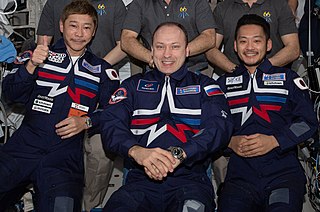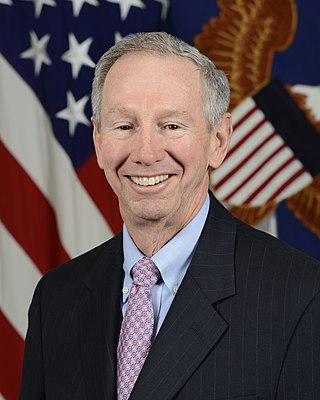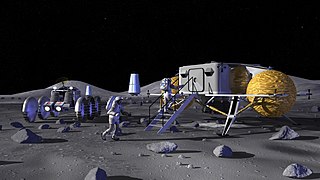
Space exploration is the use of astronomy and space technology to explore outer space. While the exploration of space is currently carried out mainly by astronomers with telescopes, its physical exploration is conducted both by uncrewed robotic space probes and human spaceflight. Space exploration, like its classical form astronomy, is one of the main sources for space science.

Space tourism is human space travel for recreational purposes. There are several different types of space tourism, including orbital, suborbital and lunar space tourism.

Scott Jay "Doc" Horowitz is a retired American astronaut and a veteran of four Space Shuttle missions.

The Vision for Space Exploration (VSE) was a plan for space exploration announced on January 14, 2004 by President George W. Bush. It was conceived as a response to the Space Shuttle Columbia disaster, the state of human spaceflight at NASA, and as a way to regain public enthusiasm for space exploration.

Private spaceflight refers to spaceflight activities undertaken by non-governmental entities, such as corporations, individuals, or non-profit organizations. This contrasts with public spaceflight, which is traditionally conducted by government agencies like NASA, ESA, or JAXA.

Michael Douglas Griffin is an American physicist and aerospace engineer who served as the Under Secretary of Defense for Research and Engineering from 2018 to 2020. He previously served as Deputy of Technology for the Strategic Defense Initiative, and as Administrator of NASA from April 13, 2005, to January 20, 2009. As NASA Administrator Griffin oversaw such areas as private spaceflight, future human spaceflight to Mars, and the fate of the Hubble telescope.
The International Space Development Conference (ISDC) is the annual conference of the National Space Society (NSS). Now in its 41st year, these conferences connect the general public and the NSS membership with leaders of contemporary space efforts. The ISDC provides a nexus for industry, government, scientists, advocates, and the public to meet and discuss the latest issues in space technology, science, policy, commerce, medicine, exploration, settlement and much more. Winners of the annual NASA space settlement Contest annually attend the conference, with several interesting activities and programs. With National Space Society's major goal being to accelerate the process of space exploration and development they also foster astronautics for students by encouraging them and getting them involved.

The Space Frontier Foundation is an American space advocacy nonprofit corporation organized to promote the interests of increased involvement of the private sector, in collaboration with government, in the exploration and development of space. Its advocate members design and lead a collection of projects with goals that align to the organization's goals as described by its credo.
The Space Frontier Foundation is an organization of people dedicated to opening the Space Frontier to human settlement as rapidly as possible.
Our goals include protecting the Earth’s fragile biosphere and creating a freer and more prosperous life for each generation by using the unlimited energy and material resources of space.
Our purpose is to unleash the power of free enterprise and lead a united humanity permanently into the Solar System.

NASA proposed several concept moonbases for achieving a permanent presence of humans on the Moon since the late 1950s. Research and exploration of the Moon has been a large focus of the organization since the Apollo program. NASA's peak budget was in 1964-1965, when it comprised 4% of all federal spending in service of the Apollo Moon landing project. Though lunar landings ever since the conclusion of the Apollo program in 1972 have ceased, interest in establishing a permanent habitation on the lunar surface or beyond low Earth orbit has remained steady. Recently, renewed interest in lunar landing has led to increased funding and project planning. NASA requested an increase in the 2020 budget of $1.6 billion, in order to make another crewed mission to the Moon under the Artemis program by 2025, followed by a sustained presence on the Moon by 2028. A crew was selected for the planned crewed mission, Artemis II, in April 2023.

A moonbase is a facility on or below the surface of the Moon, enabling human activity on the Moon. As such, it is different from a lunar space station in orbit around the Moon, like the planned Lunar Gateway of the Artemis program. Moonbases can be for robotic or human use, in both cases not necessarily including lunar habitation facilities.

The Space Exploration Initiative was a 1989–1993 space public policy initiative of the George H. W. Bush administration.

The idea of sending humans to Mars has been the subject of aerospace engineering and scientific studies since the late 1940s as part of the broader exploration of Mars. Long-term proposals have included sending settlers and terraforming the planet. Currently, only robotic landers and rovers have been on Mars. The farthest humans have been beyond Earth is the Moon, under the NASA's Apollo program.
The NASA Decadal Planning Team (DPT) and its successor, the NASA Exploration Team (NExT), were influential behind-the-scenes efforts to develop a major new direction for the space agency early in the 21st Century.
Space policy is the political decision-making process for, and application of, public policy of a state regarding spaceflight and uses of outer space, both for civilian and military purposes. International treaties, such as the 1967 Outer Space Treaty, attempt to maximize the peaceful uses of space and restrict the militarization of space.

The National Aeronautics and Space Administration is an independent agency of the U.S. federal government responsible for the civil space program, aeronautics research, and space research. Established in 1958, it succeeded the National Advisory Committee for Aeronautics (NACA) to give the U.S. space development effort a distinctly civilian orientation, emphasizing peaceful applications in space science. It has since led most American space exploration, including Project Mercury, Project Gemini, the 1968–1972 Apollo Moon landing missions, the Skylab space station, and the Space Shuttle. It currently supports the International Space Station and oversees the development of the Orion spacecraft and the Space Launch System for the crewed lunar Artemis program, the Commercial Crew spacecraft, and the planned Lunar Gateway space station.

The National Space Council is a body within the Executive Office of the President of the United States created in 1989 during the George H. W. Bush administration, disbanded in 1993, and reestablished in June 2017 by the Donald Trump administration. It is a modified version of the earlier National Aeronautics and Space Council (1958–1973).

The Review of United States Human Space Flight Plans Committee, better known as the HSF Committee, Augustine Commission, or Augustine Committee, was a group convened by NASA at the request of the Office of Science and Technology Policy (OSTP), to review the nation's human spaceflight plans to ensure "a vigorous and sustainable path to achieving its boldest aspirations in space." The review was announced by the OSTP on May 7, 2009. It covered human spaceflight options after the time NASA had planned to retire the Space Shuttle. A summary report was provided to the OSTP Director John Holdren, White House Office of Science and Technology Policy (OSTP), and NASA Administrator on September 8, 2009. The estimated cost associated with the review was expected to be US$3 million. The committee was scheduled to be active for 180 days; the report was released on October 22, 2009.

The space policy of the United States includes both the making of space policy through the legislative process, and the implementation of that policy in the United States' civilian and military space programs through regulatory agencies. The early history of United States space policy is linked to the US–Soviet Space Race of the 1960s, which gave way to the Space Shuttle program. At the moment, the US space policy is aimed at the exploration of the Moon and the subsequent colonization of Mars.

t/Space was an American aerospace company which participated in NASA's Commercial Orbital Transportation Services (COTS), and later, Commercial Crew Development (CCDev) programs for delivering cargo and crew to the International Space Station. The company was headquartered in Reston, Virginia.

Camille Wardrop Alleyne is a Trinidadian aerospace engineer, space scientist, and science ambassador. She is the Associate Program Scientist for the international Space Station at NASA's Johnson Space Center in Houston, Texas.















